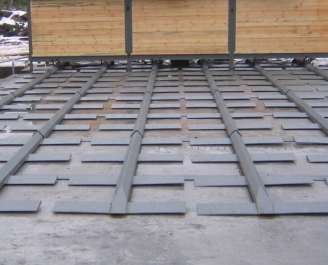ZOD silos

The Timber Waste Container (ZOD) is designed for storage of ground material (chips, sawdust, etc.) produced in the woodworking process.
The main component of the container is a cylindrical shell, defining the usable capacity of the silo. Below the shell is a hopper with a supporting frame and a mechanical discharge system. The upper part contains anti-explosion panels that protect the container against damage in case of dust explosion. Additionally, the silo is fitted with a dry fire protection system. The roof of the silo allows installation of an air transfer system cyclone.
The following optional equipment is offered with the silo: worm conveyor for quick material discharge or boiler plant supply.
Container biomass extractor KWP

KWP type biomass container with an extractor is designed for storage and feeding fuel to a combustion unit. Depending on the needs of the combustion unit, the fuel may be sawdust or chipped wood with the maximum humidity of 40%. The container loading space is cuboid in shape.
At the bottom, there is a hydraulic extractor made of welded profiles. It performs reciprocating movement along the guides on the bottom of the container. The extractor arms, due to their proper shape, transfer the fuel towards the feed chute with an operating conveyor. The extractor is driven by a hydraulic system with an actuator.
Hydraulic biomass extractor HWP

The HWP hydraulic extractor with worm conveyors (horizontal and slant) or redler extracts sawdust, wood chips or other biomass from the rectangular container and transfers the fuel to the combustion chamber of the heating plant or another connected unit.
The extractor is made of welded profiles and plates. It performs reciprocating movement along the guides on the bottom of the container. The extractor is driven by a hydraulic system with an actuator. The fuel is transferred by the extractor to a horizontal conveyor or a redler and finally to connected units.
Worm conveyors

The ZP worm conveyor is designed for transfer of biomass in form of sawdust, ground bark or chips produced in the woodworking process. We offer straight and slant conveyors The conveyor assembly can be adjusted to manual feeding or collecting fuel from a storage unit, e.g. sawdust container. Generally, the worm conveyor is used for feeding sawdust to the buffer tanks of the AZSD furnace or ZGH heating unit.
The conveyors have bent and welded steel structures, with enamel anti-corrosive coat. The main conveyor section is a U-shaped bent casing with screwed-on covers. Inside the casing there is a conveyor screw shaft, driven with a gear motor. The power from the gear motor is transferred to the shaft by an overload release coupling. The opposite end of the shaft is supported by a bearing assembly. The conveyor screw shaft is made of spiral segments.
Spring fuel extractor
The spring fuel extractor is designed for extraction of biomass in form of sawdust, wood chips, etc. from storage areas located at the same level as the boiler plant to a combustion unit transfer assembly.
The ZWP-S includes a worm conveyor and a disc with separately driven spring arms. The material stored in a container above the disc is scraped to an open chute of the worm conveyor. The extractor arms can yield, depending on the resistance of the fuel mass.
ZWT type extractors
The sawdust extractor assembly is used for extracting sawdust from a container. It is suitable for containers with a sufficiently rigid bottom.
The extractor has a hopper-shaped bucket with a flange and a toothed ring on which the conveyor screw moves. The extractor is driven by a gear motor through a jointed shaft. In the lower part, there is a scraper that transfers the sawdust through a discharge outlet. It also has inspection hatches.
Redlers
A redler type scraper conveyor is designed for transfer of fuel to a piston feeder, that is a boiler component, especially if used for combustion of a mixture of bark, sawdust and chipped production timber.
The conveyor has a casing in form of a chute with chain connectors of the drive and the tensioning mechanism. The fuel is transferred along a fixed chute surface by the crosspieces installed on a double chain connector. The conveyor is fed through a hopper opening on the chute cover. The fuel is discharged through an opening in the chute bottom.
Discover our realization
Contact us for free consultation. Go to the contact form







